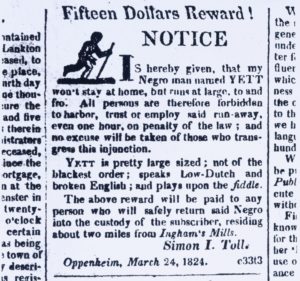I love primary historical sources. Cornell University has just made public a database of historical fugitive slave ads, including one for a slave who ran away from George Washington! (Oney Judge escaped our first president and went on to marry a free black sailor and live out the rest of her life in New Hampshire; sounds like wonderful inspiration for a romance to me).

Advertisement for a fugitive slave in the Oppenheim (New York, 1824) (via Schomburg Center for Research in Black Culture, Manuscripts, Archives and Rare Books Division, New York Public Library)
Though these ads we can discover details of the true lives of the enslaved, and hopefully find inspiration for creating works of fiction that reflect the diverse reality of the past. We can see what they wore, what skills they had, what work they did, and even what ruses they used to escape (we can also see the cruelty of their enslavers exposed in the descriptions of the scars they bore). But more than that, we can see that they were there. That they were real. That they had hopes and dreams and that they fought for those dreams every bit as much as we do today.
But, Isobel I hear you say, I write UK-set historicals. Well, there is another, similar database for researching this topic in the UK: Runaway Slaves in Britain. The ads of slave sales taking place in the UK in the 18th century send my imagination running wild. So many stories waiting to be told…

Isobel, thanks for sharing these two resources! The UK database will be fascinating reading for me in the new year. Newspapers are my favorite research tool (but sadly, even today not all of them are online). When I wrote The Captain’s Dilemma, I needed to know how he had escaped from the prisoner-of-war prison and was lucky to find a description of just such an escape in the local newspapers from the period. But I researched that book on-site in England, and read that newspaper at the local library. So much easier now as more and more resources, like your escaped-slave databases, are put on the Internet!